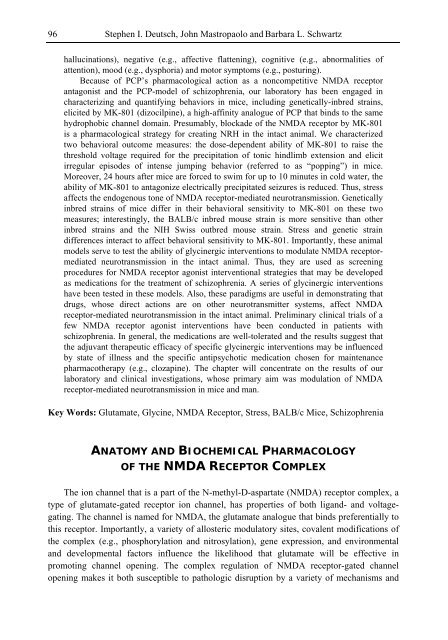Schizophrenia Research Trends
Schizophrenia Research Trends
Schizophrenia Research Trends
- No tags were found...
Create successful ePaper yourself
Turn your PDF publications into a flip-book with our unique Google optimized e-Paper software.
96Stephen I. Deutsch, John Mastropaolo and Barbara L. Schwartzhallucinations), negative (e.g., affective flattening), cognitive (e.g., abnormalities ofattention), mood (e.g., dysphoria) and motor symptoms (e.g., posturing).Because of PCP’s pharmacological action as a noncompetitive NMDA receptorantagonist and the PCP-model of schizophrenia, our laboratory has been engaged incharacterizing and quantifying behaviors in mice, including genetically-inbred strains,elicited by MK-801 (dizocilpine), a high-affinity analogue of PCP that binds to the samehydrophobic channel domain. Presumably, blockade of the NMDA receptor by MK-801is a pharmacological strategy for creating NRH in the intact animal. We characterizedtwo behavioral outcome measures: the dose-dependent ability of MK-801 to raise thethreshold voltage required for the precipitation of tonic hindlimb extension and elicitirregular episodes of intense jumping behavior (referred to as “popping”) in mice.Moreover, 24 hours after mice are forced to swim for up to 10 minutes in cold water, theability of MK-801 to antagonize electrically precipitated seizures is reduced. Thus, stressaffects the endogenous tone of NMDA receptor-mediated neurotransmission. Geneticallyinbred strains of mice differ in their behavioral sensitivity to MK-801 on these twomeasures; interestingly, the BALB/c inbred mouse strain is more sensitive than otherinbred strains and the NIH Swiss outbred mouse strain. Stress and genetic straindifferences interact to affect behavioral sensitivity to MK-801. Importantly, these animalmodels serve to test the ability of glycinergic interventions to modulate NMDA receptormediatedneurotransmission in the intact animal. Thus, they are used as screeningprocedures for NMDA receptor agonist interventional strategies that may be developedas medications for the treatment of schizophrenia. A series of glycinergic interventionshave been tested in these models. Also, these paradigms are useful in demonstrating thatdrugs, whose direct actions are on other neurotransmitter systems, affect NMDAreceptor-mediated neurotransmission in the intact animal. Preliminary clinical trials of afew NMDA receptor agonist interventions have been conducted in patients withschizophrenia. In general, the medications are well-tolerated and the results suggest thatthe adjuvant therapeutic efficacy of specific glycinergic interventions may be influencedby state of illness and the specific antipsychotic medication chosen for maintenancepharmacotherapy (e.g., clozapine). The chapter will concentrate on the results of ourlaboratory and clinical investigations, whose primary aim was modulation of NMDAreceptor-mediated neurotransmission in mice and man.Key Words: Glutamate, Glycine, NMDA Receptor, Stress, BALB/c Mice, <strong>Schizophrenia</strong>ANATOMY AND BIOCHEMICAL PHARMACOLOGYOF THE NMDA RECEPTOR COMPLEXThe ion channel that is a part of the N-methyl-D-aspartate (NMDA) receptor complex, atype of glutamate-gated receptor ion channel, has properties of both ligand- and voltagegating.The channel is named for NMDA, the glutamate analogue that binds preferentially tothis receptor. Importantly, a variety of allosteric modulatory sites, covalent modifications ofthe complex (e.g., phosphorylation and nitrosylation), gene expression, and environmentaland developmental factors influence the likelihood that glutamate will be effective inpromoting channel opening. The complex regulation of NMDA receptor-gated channelopening makes it both susceptible to pathologic disruption by a variety of mechanisms and
















